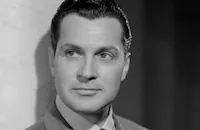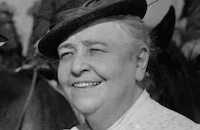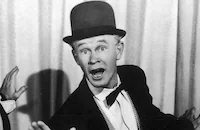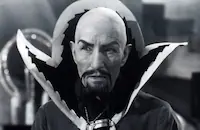Ramona
Brief Synopsis
Cast & Crew
Henry King
Loretta Young
Don Ameche
Kent Taylor
Pauline Frederick
Jane Darwell
Film Details
Technical Specs

Synopsis
In 1870 California, at the hacienda of Señora Moreno, everyone prepares for a fiesta and the arrival of Father Salvierderra, who will celebrate Mass for the ranch inhabitants and the Indians who are making their yearly appearance to shear the sheep. The Señora welcomes her handsome son Felipe and sends him to find Ramona, the Señora's lovely ward, who has gone to meet Salvierderra. After they all arrive back at the hacienda, Felipe also welcomes Alessandro, the Indian leader. That night, at the fiesta, Felipe tells Ramona how beautiful she is, and while Ramona feels a sisterly affection for him, it is obvious that she does not share his passion. Alessandro sees her dancing and finds out who she is, while elsewhere, the Señora complains to Salvierderra about Felipe's interest in Ramona. The next morning, as everyone goes to Mass, Ramona, charmed by Alessandro's singing, questions Felipe about him. That afternoon, Felipe falls from his horse and is seriously injured during a race with Alessandro. Weeks later, after Felipe's recovery, Alessandro is about to leave when Ramona declares her love for him, and he asks her to marry him. The Señora, alerted by the jealous servant Margarita, who loves Alessandro herself, sends Alessandro away, and tells Ramona that she will have to go to a convent. The Señora then informs Ramona that her mother was an Indian, and her father a former suitor of the Señora's sister, who adopted Ramona as a baby and then appointed the Señora her guardian when she herself died. Ramona is pleased by the scandalous news, and feels that, as an Indian, she belongs with Alessandro. Later that night, Felipe helps her sneak out of her room and meet Alesssandro. The lovers are married and, years later, have a baby girl and a prosperous farm until white settlers are given title to the Indian lands by the government. A bitter Alessandro packs up his family and they are forced by a rainstorm to stop at the cabin of kindly Aunt Ri, whose distrust of Indians is put aside upon finding out that they are Christians. They are still there two days later, unable to leave due to the baby's fever. Alessandro rides to town for Dr. Weaver, who cannot leave because many others are also ill. On the way back, his horse becomes lame, so Alessandro goes to Jim Farrar's house, where he takes a horse after not finding Farrar, who returns in time to see Alessandro leaving. When Alessandro reaches home, he comforts Ramona with a lie that the doctor will come soon. Farrar arrives, and Ramona mistakes him for the doctor as he goes to find Alessandro, whom he shoots on sight. After Alessandro's funeral, Aunt Ri tells Ramona to be grateful for the baby, and as they walk to the cabin, Ramona sees Felipe, who has come to help her. Ramona holds her baby and smiles through her tears, glad that she has some part of Alessandro still with her.

Director
Henry King
Cast

Loretta Young

Don Ameche

Kent Taylor

Pauline Frederick

Jane Darwell
Katherine De Mille
Victor Kilian

John Carradine

J. Carrol Naish
Pedro De Cordoba
Charles Waldron
Claire Du Brey
Russell Simpson

William Benedict
Robert Spindola
Chief Thunder Cloud
Erville Alderson
Martin Faust
Del Campo
Donald Reed
Enrico Ricardi
A. Van Nostrand
Dillon Ober
Cecil Weston
Evelyn Selbie
Kathryn Sheldon
Helen Sky Eagle

Charles Middleton
Tom London
Ethan Laidlaw
Lee Kohlmar
D'arcy Corrigan
Beverly Firestine
Edna Lawrence
Velma Mccandless
Anita Camargo
Delores Reyes
Carmen La Roux
Colleen Traxler
Maria Morales
Maria Iturbi
Lita Cortez
Laura Puente
Frances Norton
Elena Durán
Janet Barrett
Muriel Barrett
Maclovia Ruiz
Jose Bottolo
George Mendoza
Paul Loredo
Alfonso De Larios
Miguel Fernandez
Jess Escobar
Rudolfo Mendina
Guy Scarpitta
George Travell
Ramon Ros
David Robel
Tito Renaldo
Cesar Tapia
Fred Velasco
Lewis Orozco
Charles Harrison
Rafael Sino
Edward Mestas
Charles Tosi
Bahe Denetdeel
Big Eagle Penna
Adolf Ruiz
James Lono
I. R. Swift Eagle
Elmo Red Fox
John Isaac
Roy Bellas
Harold Morongo
Tom Humphrey
Sonny Chorre
Clarence Morrow
Delmar Costello
Richard Botiller
Frank Leyva
Paul Lopez
Dave Kashner
Joe De La Cruz
Sam Appel
Lillian Nicholson
Gertrude Chorre
Mary Lopez
Shilia Fritz
Lucille Porcett
Soledad Gonzales
Marie Chorre
Anita Ray
Carmen Bailey
Lucille Miller
Christine Gossett
Dorothy Jones
Delores Young
Emilie Cabanne
Gertrude Pedlar
Rubí Gutiérrez
Julia Bejarano
Myrta Bonillas
Beulah Parkington
Elsie Bishop
Margaret Morgan
Enrique Acosta
James Cooley
Henry Orozco
Fred Godoy
Manuel Lopez
Valentine Martin
Guillermo Arcos
Louis Aldez
Captain Fernando Garcia
Crew
Joseph Aiken
Stuart Anthony
Duncan Cramer
Tito A. Davison
Al De Gaetano
Jose Fernandez
Paul Hervey Fox
L. Wolfe Gilbert
Natalie Kalmus
William Kernell
Harry M. Leonard
Sonya Levien
Chester Lyons
R. C. Moore
Alfred Newman
William V. Skall
John Stone
Lamar Trotti
Gwen Wakeling
Mabel Wayne
Robert Webb
Ern Westmore
Lillian Wurtzel
Sol M. Wurtzel
Darryl F. Zanuck

Film Details
Technical Specs

Quotes
Trivia
Notes
A 18 September 1934 Variety news item announcing Fox's purchase of the rights to Ramona from Edwin Carewe, who had produced an earlier version of Helen Hunt Jackson's novel, noted that a Spanish version was also likely to be filmed, however, none was made. A January 30, 1935 Hollywood Reporter news item noted that Philip Klein and Robert Yost had been signed to work on the adaptation, but their contribution to the completed picture has not been confirmed. Pre-production work on this film began before Twentieth Century and Fox merged in the summer of 1935, while actual shooting was done after the merger. A March 18, 1935 Hollywood Reporter news item states that John Ford was scheduled to direct the film, while the Twentieth Century-Fox Records of the Legal Department at the UCLA Theater Arts Library add that Eugene Forde was originally signed as the director before Henry King. Hollywood Reporter news items also noted that Lew Pollack and Paul Francis Webster had been assigned to write the music for the picture. Among the actors considered for the part of "Alessandro" were Pietro Gentili, Phillip Reed, Gilbert Roland (who was also considered for the part of "Felipe") and John Boles (who was released from the role when he ended his contract with the studio). A August 24, 1935 Hollywood Reporter news item reported that Charles Sellon, who was cast as "Juan Can," was forced to drop out of the film due to illness, and the legal records confirm that O. P. Heggie, who was contracted to play "Father Salvierderra," went instead into Twentieth Century-Fox's 1936 production, The Prisoner of Shark Island (see below). According to Hollywood Reporter news items, Frances Dee was considered for the part of "Ramona," which was first assigned to Rita Hayworth (then known as Rita Cansino,) and then to Loretta Young after Darryl F. Zanuck, Twentieth Century-Fox's vice-president in charge of production, announced that "the story is in the special class and deserves more elaborate treatment than formerly called for." Production was delayed from late Jul, and Twentieth Century-Fox considered removing Kent Taylor, who had been borrowed from Paramount for the role of "Felipe," to replace him with "a more important name," however, Taylor did play the part. The film was again postponed in late August 1935 by Young's illness. When she was still not ready to begin by mid-October 1935, she was replaced by Rochelle Hudson. In late Oct, Zanuck announced that the picture was to be shot in Technicolor, which, because the film would be "80 percent exteriors," required another postponement to avoid the rainy season. By the time shooting began on May 11, 1936, Young had been reinstated in the part of "Ramona."
The film was shot on location at Warner Hot Springs and the Mesa Grande Indian Reservation, both in San Diego County, CA. According to a modern source, the Indian extras from the reservation were descendents of the Indians about whom Jackson wrote her novel. A June 17, 1936 Los Angeles Times news item reported that Young saved two-year-old Raymond Lugo, with whom she was performing a scene, from a fire that started on the set in Mesa Grande. Althuogh Hollywood Reporter production charts list Paul Stanton and Fritz Leiber as cast members, their participation in the completed film has not been confirmed. According to a Hollywood Reporter news item, the picture's release was delayed because Technicolor could not supply enough prints in time to meet the deadline. Although a September 9, 1936 Hollywood Reporter news item noted that Ramona was to have its world premiere simultaneously in Pittsburgh and Bar Harbor, ME, the date of the premiere has not been confirmed. This was the first Twentieth Century-Fox film shot in Technicolor. The New York Times reviewer praised the color, commenting: "Chromatically, the picture is superior to anything we have seen in the color line," and the Variety reviewer noted: "...the fact that the color angle becomes less noticeable as the picture unwinds, and never interferes with the telling or reception of the story, is evidence that color has finally found its place in film production." According to a September 15, 1935 New York Times article, the film was estimated to cost in excess of $750,000 to produce, but in a modern source, King stated that it was produced for a little under $600,000. Jackson's novel was previously filmed three times, all of which were titled Ramona. The first version, a 1910 Biograph film, was directed by D. W. Griffith and starred Mary Pickford and Henry B. Walthall (see Film Beginnings, 1893-1910; A.12778). Donald Crisp directed Adda Gleason and Monroe Salisbury in the 1916 Clune Film Producing Co. version and Edwin Carewe directed Dolores Del Rio and Warner Baxter in the 1928 Inspiration Pictures production. From 1922 to the early 1940s, a "Ramona Pageant" was held every spring in a natural outdoor amphitheatre near Hemmet, CA. The pageant, which was resumed after World War II, recreated incidents from Jackson's book. In the 1936 pageant, John Carradine played "Jim Farrar," which was also his role in the film. According to modern sources, the producers of the picture viewed the pageant in the early 1930s for ideas.

Miscellaneous Notes
Released in United States 1936
Released in United States March 1977
Released in United States 1936
Released in United States March 1977 (Shown at FILMEX: Los Angeles International Film Exposition (Treasures from UCLA Archives) March 9-27, 1977.)











